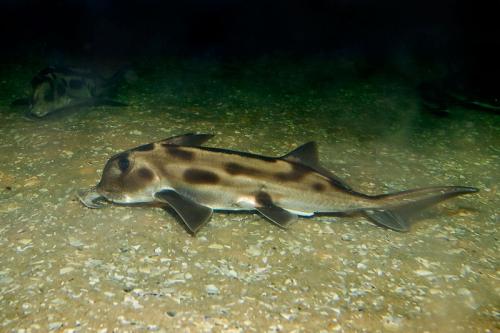A team of researchers including SF State Assistant Professor of Biology Scott Roy has sequenced the entire genome of the elephant shark, uncovering several features that may shed light on the evolution of bony vertebrates.
The study is the first whole-genome analysis of a cartilaginous fish. Cartilaginous fishes include sharks, rays and skates. Together with bony fish, birds, reptiles, amphibians and mammals, they make up the branch of jawed vertebrates on life's family tree.
The elephant shark genome is relatively small, consisting of slightly fewer than a billion DNA base pairs compared with 3 billion base pairs in humans. But this spare sequence has yielded some intriguing details, the researchers write. For instance, the elephant shark lacks the genes for secreted phosphoproteins, which may explain why their cartilage is not converted into bone as in the other jawed vertebrates.
They also lack the genes for several key immune system cells and protein receptors in the adaptive immune system, which provides carefully targeted defenses against specific disease threats. This finding, say the researchers, may suggest that the adaptive immune system in jawed vertebrates gradually became more elaborate over time.
One of the most notable features of the elephant shark's genome is its incredibly slow rate of evolution, said Roy. Even slower than in "living fossils" such as the coelacanth, the elephant shark's genome has not changed substantially in hundreds of millions of years.
This slow rate of evolution was uncovered in part by Roy's analysis of the genome's introns. Introns are the part of the genetic sequence that "interrupts" genes, and must be spliced out before the gene can be expressed. In vertebrates, these introns can be thousands of DNA letters long and must include their own splicing instructions.
There have been very few intron changes in the elephant shark genome, but this isn't entirely surprising, noted Roy, who has studied intron organization across a variety of organisms, including humans. "It's pretty well established in vertebrates that very little of this intron loss and creation occurs."

The immune system of the elephant shark is simpler than many other vertebrates studied so far. The present studies also explain, why cartilaginous fishes do not generate human-like bones. Credit: Fir0002/Flagstaffotos
"It would be a rare and weird physical event" for this many nucleotides to exactly appear or disappear in a genome, he added. "It's unlikely to have that big of a change exactly and all at once."
The elephant shark genome helps to confirm that the lack of intron loss and gain is a general characteristic of vertebrates, Roy said. In close invertebrate relatives such as the tunicates (which include marine animals such as sea squirts), the rate of intron evolution is much faster. "Because vertebrate introns are very long, this may make it harder to create and delete them," Roy said. "In some tunicates, introns are about 40 nucleotides long, and this simply may make it easier for them to come and go over time."
The time between generations also tends to be much swifter in invertebrates than vertebrates, he noted, which may increase the opportunity for mutations to accumulate in invertebrate genomes.
These slow-changing introns also helped Roy and his colleagues clarify the relationship between cartilaginous fish and other jawed vertebrates. These relationships can be determined by comparing gene sequences between organisms, and introns can be especially helpful in this analysis. "Because things are changing so slowly with [introns], the chance that two species will share a change is likely to be very small" unless they are closely related, Roy explained.
The researchers found "a very clear signal," Roy said, that bony fish and other bony vertebrates including mammals are all more closely related to each other than either group is to the cartilaginous fishes.





